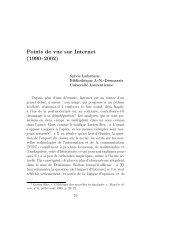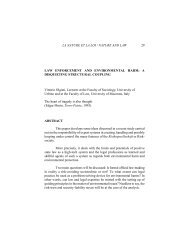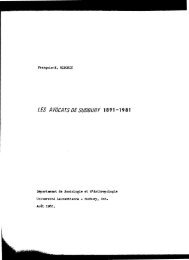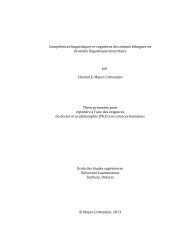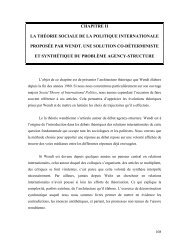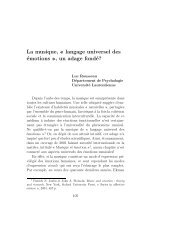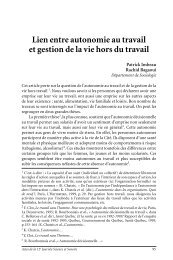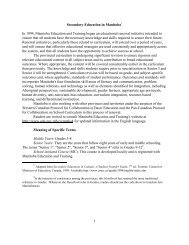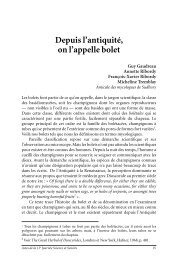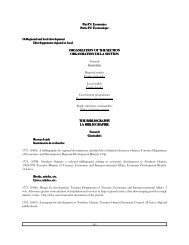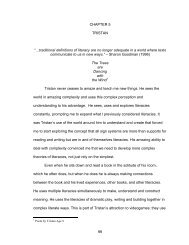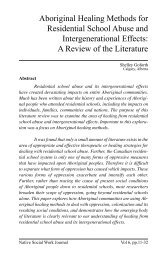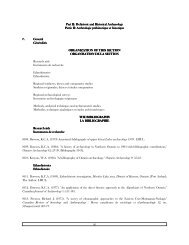- Page 2 and 3:
For any questions, please contactPo
- Page 4:
2Kabwe Nkongolo with/avec Peter Bec
- Page 10 and 11:
8kind of work, which is not the cas
- Page 13 and 14:
ForewordPréfaceDr. Liette VasseurA
- Page 15 and 16:
IntroductionNSERC (pronounced n’s
- Page 17:
point de vue d’un chercheur qui a
- Page 20 and 21:
18are limited in time and the direc
- Page 23 and 24:
Research, Development and Creativit
- Page 25 and 26:
Department of BiologyDépartement d
- Page 27 and 28:
25Madhur AnandDisturbance dynamics
- Page 29 and 30:
27Mery Martinez GarciaPhysiological
- Page 31 and 32:
29John Gunn with/avec William Kelle
- Page 33 and 34:
31Jacqueline LitzgusGeographic vari
- Page 35 and 36:
33Kabwe NkongoloGenome organization
- Page 37 and 38:
35Kabwe Nkongolo with/avec Peter Be
- Page 39 and 40:
37Charles RamcharanNew directions i
- Page 41 and 42:
39Peter RyserEcological significanc
- Page 43 and 44:
41Albrecht Schulte-Hostedde with/av
- Page 45 and 46:
Department of Chemistry andBiochemi
- Page 47 and 48:
45Nelson Belzile 1Biogeochemistry o
- Page 49 and 50:
47François CaronMethod development
- Page 51 and 52:
Altogether, this research program w
- Page 53 and 54:
51Éric GauthierWater-jacketed CO 2
- Page 55 and 56:
53Helen JolyMetal-atom mediated che
- Page 57 and 58:
55Hoyun LeeDetermining the hamster
- Page 59 and 60:
57Louis MercierFunctional nanoporou
- Page 61 and 62:
59Sabine MontautCancer chemoprevent
- Page 63 and 64:
61Sabine Montaut with/avec Nelson B
- Page 65 and 66:
63Stefan SiemannRole of Metal Ions
- Page 67 and 68:
65Stefan Siemann with/avec Éric Ga
- Page 69 and 70:
The funding will enable the recruit
- Page 71:
2. extend our ability to use second
- Page 74 and 75:
72sea level high stand and low stan
- Page 76 and 77:
74and prosperity are linked to succ
- Page 78 and 79:
76Bruno LafranceStructural controls
- Page 80 and 81:
78C. Michael LesherIn partnership w
- Page 82 and 83:
80Darrel LongPrecambrian and Early
- Page 84 and 85:
82The ultimate goal is to address h
- Page 86 and 87: 84Phillips ThurstonGreenstone belt
- Page 89 and 90: Geomechanics Research CentreCentre
- Page 91 and 92: 89Peter KaiserIn partnership with/E
- Page 93 and 94: Department of Mathematics andComput
- Page 95 and 96: 93Stephanie CzaporApplications of S
- Page 97 and 98: 95Julia JohnsonReverse rough set me
- Page 99 and 100: 97Nicolas RobidouxCochain-based num
- Page 101 and 102: cet univers. L’idée de base de l
- Page 103 and 104: Department of Physics and Astronomy
- Page 105 and 106: 103Gennady ChitovOrdering and Corre
- Page 107 and 108: 105advantage of not requiring liqui
- Page 109 and 110: 107extremely sensitive experiments
- Page 111 and 112: School of Commerce and Administrati
- Page 113 and 114: School of EngineeringÉcole de gén
- Page 115 and 116: 113Gregory BaidenTelemining researc
- Page 117 and 118: 1151. continually verifying the cap
- Page 119 and 120: 117Vassilios KazakidisFlexibility a
- Page 121 and 122: 119Helen (Huilan) ShangIdentificati
- Page 123 and 124: 121Nick VayenasReliability assessme
- Page 125 and 126: 123Turgut YalcinDissolved gas appli
- Page 127 and 128: 125Zhibin YeDeveloping advanced pol
- Page 129 and 130: School of Human KineticsÉcole des
- Page 131 and 132: 129Robin MichelNerve trophic contro
- Page 133 and 134: 131Robin Michel with/avec Éric Gau
- Page 135: Northern Ontario School of Medicine
- Page 139 and 140: Partners with Laurentian University
- Page 141 and 142: 139Fiona Hunter with/avec M. J. Bid
- Page 143 and 144: 141heavy water. The SNO experiment
- Page 145 and 146: David Sinclair with/avec A. Belleri




